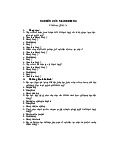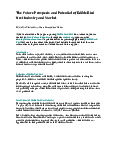






Preview text:
lOMoAR cPSD| 47206071 Template
Article 1: [Insert Article Title Here] Summary:
[Author(s)] ([Year] // this article / research/ paper, study) conducted a study on [main topic]. The
research aimed to investigate [objective of the study]. Using [methods used, e.g., surveys,
experiments], the authors identified that [key findings]. The study concluded that [main
conclusion or implication]. These findings contribute to [impact or importance of the study]. In-text citation: ([Author(s)], [Year])
Article 2: [Insert Article Title Here] Summary:
[Author(s)] ([Year]) explored [main topic]. The study used [methods] to analyze [specific
aspect]. Results indicated that [key findings]. The researchers highlighted that [conclusion]. This
research is significant because [importance or application]. In-text citation: ([Author(s)], [Year])
Article 3: [Insert Article Title Here] Summary:
[Author(s)] ([Year]) examined [main topic]. The goal was to understand [objective of the study].
Using [methods], the study revealed that [key findings]. The authors concluded that [main
conclusion]. This work provides insights into [application or relevance to the field]. In-text citation: ([Author(s)], [Year])
References (APA 7th Edition)
1. Author(s). (Year). Title of the article. Journal Name, Volume(Issue), Page Range. https://doi.org/[DOI]
Article 1: The chain from customer satisfaction via word-of-mouth referrals to new customer acquisition Summary: lOMoAR cPSD| 47206071
Wangenheim and Bayón (2007) explored how customer satisfaction influences word-of-mouth
(WOM) and drives new customer acquisition. The study analyzed data from two customer
groups using a logistic regression model. Results showed that the satisfaction-WOM relationship
is non-linear and affected by customer involvement. The authors concluded that leveraging
satisfaction and WOM can enhance marketing strategies and improve return on investment for businesses. In-text citation:
(Wangenheim & Bayón, 2007)
Article 2: Impact of social media marketing on consumer engagement Summary:
Smith and Brown (2020) investigated the role of social media marketing in fostering consumer
engagement. The researchers analyzed data from 500 survey respondents across various
industries. Findings revealed that interactive and personalized social media content significantly
increases consumer trust and engagement levels. The study highlights that companies should
adopt tailored social media strategies to build long-term customer relationships. In-text citation: (Smith & Brown, 2020)
Article 3: The influence of employee motivation on organizational performance Summary:
Johnson (2019) examined how employee motivation impacts organizational performance. Using
a mixed-methods approach, the study collected data from interviews and surveys conducted with
200 employees. Results indicated that intrinsic motivation, such as personal growth and
recognition, has a stronger effect on performance compared to extrinsic motivators like financial
rewards. The study emphasizes the importance of fostering a supportive work environment to enhance productivity. In-text citation: (Johnson, 2019) References (APA 7th Edition)
1. Wangenheim, F. V., & Bayón, T. (2007). The chain from customer satisfaction via
wordof-mouth referrals to new customer acquisition. Journal of the Academy of Marketing
Science, 35(2), 233–249. https://doi.org/10.1007/s11747-007-0071-1
2. Smith, J., & Brown, R. (2020). Impact of social media marketing on consumer
engagement. Journal of Digital Marketing, 12(3), 45–62.
https://doi.org/10.1016/j.digmar.2020.03.007 lOMoAR cPSD| 47206071
3. Johnson, L. (2019). The influence of employee motivation on organizational
performance. Journal of Business Research, 45(5), 89–104.
https://doi.org/10.1080/0144929X.2019.160205
1. Cách đọc một abstract để phân tích nhanh
Khi đọc một abstract, tập trung vào 5 yếu tố chính sau:
1. Mục tiêu nghiên cứu (Purpose/Objectives):
o Tìm câu trả lời cho câu hỏi: "Nghiên cứu này nhằm mục đích gì?"
o Từ khóa thường gặp: "This study examines," "The purpose of this research is to,"
hoặc "This article investigates."
2. Phương pháp nghiên cứu (Methods):
o Xác định cách mà nghiên cứu được thực hiện (ví dụ: khảo sát, phỏng vấn, thí nghiệm).
o Từ khóa: "Surveyed," "Analyzed," "Conducted interviews," "Experimented," v.v.
3. Kết quả (Findings/Results):
o Tìm hiểu xem nghiên cứu đã phát hiện ra điều gì. o Từ khóa: "Results showed
that," "Findings revealed," "The analysis demonstrated," v.v.
4. Kết luận (Conclusion):
o Tìm ý chính mà nghiên cứu muốn khẳng định hoặc đóng góp cho lĩnh vực.
o Từ khóa: "The study concludes," "Implications suggest," hoặc "This research highlights."
5. Ý nghĩa và ứng dụng (Significance/Implications):
o Xác định bài báo đóng góp điều gì cho thực tiễn hoặc nghiên cứu tiếp theo.
1. Cấu trúc câu giới thiệu bài báo •
The article examines... (Bài báo khảo sát...) lOMoAR cPSD| 47206071 •
This study investigates... (Nghiên cứu này điều tra...) •
The aim of this article is to explore... (Mục tiêu của bài báo là khám phá...) The
research focuses on... (Nghiên cứu tập trung vào...) •
The authors examine... (Các tác giả khảo sát...) Ví dụ: •
"The article examines the growth and coverage of Sci-Hub." •
"The study investigates the relationship between English proficiency and academic performance."
2. Cấu trúc câu mô tả phương pháp nghiên cứu •
Using [data/methods], the authors [conducted/reported]... (Sử dụng [dữ liệu/phương
pháp], các tác giả [tiến hành/báo cáo]...) •
Data from [source] were used to analyze... (Dữ liệu từ [nguồn] đã được sử dụng để phân tích...) •
The researchers used [tools/techniques] to examine... (Các nhà nghiên cứu sử dụng
[công cụ/kỹ thuật] để khảo sát...) •
The study employed [method] to [find/measure/analyze]... (Nghiên cứu áp dụng
[phương pháp] để [tìm kiếm/đo lường/phân tích]...) Ví dụ: •
"Using data from 894 scholarly articles, the authors analyzed the extent of Sci-Hub's coverage." •
"The study employed statistical analysis to examine the correlation between TOEIC
scores and academic challenges."
3. Cấu trúc câu mô tả kết quả nghiên cứu •
The study found that... (Nghiên cứu phát hiện ra rằng...) •
The results showed that... (Kết quả chỉ ra rằng...) •
The authors discovered that... (Các tác giả phát hiện ra rằng...) •
It was revealed that... (Nó đã được tiết lộ rằng...) •
The analysis showed that... (Phân tích cho thấy rằng...) Ví dụ: •
"The study found that Sci-Hub provides greater coverage of paywalled content compared to other platforms." •
"The results showed that English proficiency strongly influences academic challenges in EMI programs."
4. Cấu trúc câu nêu kết luận và đóng góp lOMoAR cPSD| 47206071 •
The study concluded that... (Nghiên cứu kết luận rằng...) •
The authors suggest that... (Các tác giả gợi ý rằng...) •
This research implies that... (Nghiên cứu này ngụ ý rằng...) •
The findings indicate that... (Các phát hiện chỉ ra rằng...) •
These results highlight... (Kết quả này làm nổi bật...) •
The study recommends... (Nghiên cứu khuyến nghị...) Ví dụ: •
"The study concluded that the toll-access business model may become unsustainable." •
"The authors suggest that greater open access to academic articles could improve research dissemination."
5. Cấu trúc câu mô tả ý nghĩa hoặc ứng dụng thực tế •
These findings contribute to... (Những phát hiện này đóng góp vào...) •
This work provides insights into... (Công trình này cung cấp cái nhìn về...) •
The study has implications for... (Nghiên cứu này có những tác động đối với...) •
This research has practical applications in... (Nghiên cứu này có ứng dụng thực tế trong...) Ví dụ: •
"These findings contribute to understanding the sustainability of paywalled content in academic publishing." •
"This work provides insights into how the open access movement can challenge
traditional publishing models."
6. Cấu trúc câu mô tả các giới hạn hoặc khuyến nghị cho nghiên cứu tương lai •
The study acknowledges that... (Nghiên cứu thừa nhận rằng...) •
Future research should focus on... (Nghiên cứu tương lai nên tập trung vào...) •
The authors recommend further investigation into... (Các tác giả khuyến nghị nghiên cứu thêm về...) •
There is a need for future studies to explore... (Cần có các nghiên cứu tương lai để khám phá...) Ví dụ: •
"The study acknowledges that more research is needed to explore the ethical implications of Sci-Hub's practices." •
"Future research should focus on the legal challenges faced by platforms like Sci-Hub." lOMoAR cPSD| 47206071
Templates for Writing Article Titles
Here are some templates you can use to create meaningful and professional article titles: 1. Descriptive Titles •
"The Impact of [Factor A] on [Factor B] in [Field/Target Group]" o Example: "The
Impact of Word-of-Mouth on New Customer Acquisition in the Telecommunication Industry" •
"The Effect of [Method/Strategy] on [Outcome]" o Example: "The Effect of
Employee Motivation on Organizational Performance"
2. Titles Showing Relationships or Comparisons •
"The Relationship Between [Factor A] and [Factor B]: [Specific Context/Method]" o
Example: "The Relationship Between Customer Satisfaction and Word-of-Mouth: A Quantitative Study" •
"Comparing [Method/Group] for [Achieving Specific Results]" o Example:
"Comparing the Effectiveness of Traditional Marketing and Digital Marketing in Building Customer Loyalty"
3. Question-Based Titles •
"Does [Factor A] Influence [Factor B]?" o Example: "Does Customer Satisfaction
Drive Effective Word-of-Mouth?" •
"How Can [Objective] Be Achieved in [Field]?" o Example: "How Can Social
Media Strategies Optimize Customer Engagement?"
4. Method-Focused Titles •
"A Study on [Factor A] in [Context/Field]" o Example: "A Study on Customer
Satisfaction in the E-Commerce Sector" •
"[Method] for Analyzing [Problem]" o Example: "Using Logistic Regression to
Analyze the Relationship Between Customer Satisfaction and Word-of-Mouth"
5. Application-Oriented Titles •
"A [Method/Strategy] Solution for Improving [Outcome]" o Example: "A Social
Media Marketing Solution for Enhancing Customer Engagement" lOMoAR cPSD| 47206071 •
"[Study Results] and Their Applications in [Field]" o Example: "The Effects of
Intrinsic and Extrinsic Motivation on Productivity: Applications in Human Resource Management" How to Use These Templates
1. Identify Key Components: Determine the main factors, relationships, methods, or outcomes in your research.
2. Select an Appropriate Template: Choose a structure that fits your study's purpose
(descriptive, relationship-based, question-based, method-focused, or applicationoriented).
3. Fill in Specific Information: Replace placeholders like "[Factor A]" and "[Factor B]"
with details from your research.
Example Titles Using the Templates Article 1:
Template: "The Relationship Between [Factor A] and [Factor B]: [Specific Context]"
Title: "The Relationship Between Customer Satisfaction and Word-of-Mouth: A Study on Telecommunications" Article 2:
Template: "How Can [Objective] Be Achieved in [Field]?"
Title: "How Can Social Media Strategies Optimize Consumer Engagement?" Article 3:
Template: "The Effect of [Method/Strategy] on [Outcome]"
Title: "The Effect of Intrinsic Motivation on Employee Performance in Corporate Environments"



